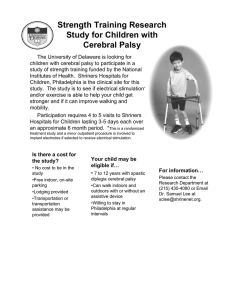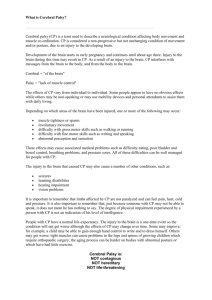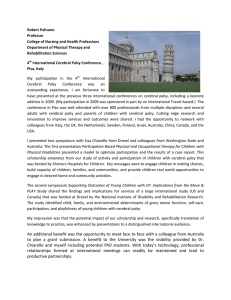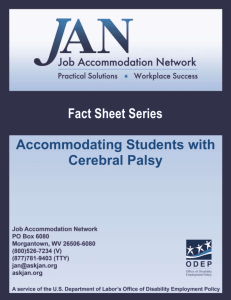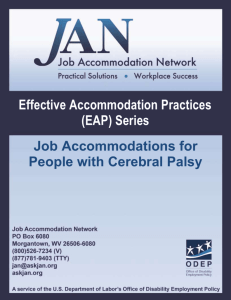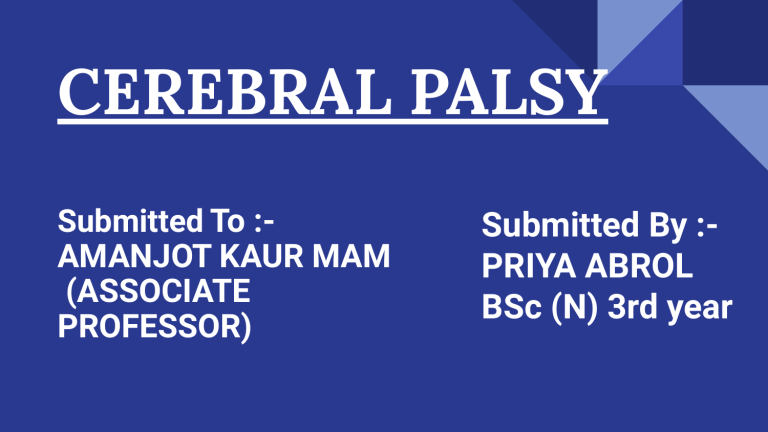
CEREBRAL PALSY Submitted To :AMANJOT KAUR MAM (ASSOCIATE PROFESSOR) Submitted By :PRIYA ABROL BSc (N) 3rd year INTRODUCTION ● CEREBRAL :- It refers to cerebrum which is affected area of brain. ● PALSY :- It refers to disorder of movement. DEFINITION Cerebral Palsy is a chronic non-progressive motor dysfunction caused by damage to the motor areas of brain. —Blosser and Burns, 2004 INCIDENCE ● Cerebral palsy (CP) is the most common motor disability in childhood. ● Recent population-based studies from around the world report prevalence estimates of CP ranging from 1 to nearly 4 per 1,000 live births or per 1,000 children. The prevalence of CP is higher for children born preterm or at low birthweight. ETIOLOGICAL FACTORS 1. PRENATAL FACTORS 2. BIRTH FACTORS ● Genetic or chromosomal anomalies ● Brain anomaly ● Exposure to teratogens ● Intrauterine infections ● Preeclampsia ● Complicated labor and delivery ● Birth injury ● Asphyxia secondary to cord prolapse or strangulation CONT…. 3. PERINATAL FACTOR 4. CHILDHOOD FACTOR ● Central nervous system infections ● Kernicterus ● Head trauma ● Meningitis ● Toxic ingestion like lead poisoning ● Shaken baby syndrome ● Foreign body aspirations Pathophysiology Damage to the motor control centers of the developing brain which can occur during pregnancy or after childbirth birth. | Activity limitations | Disturbances of sensation, depth perception and other sight based problems And communications imapirement , Cognitive impairement | Cerebral palsy CLASSIFICATION 1. 2. 3. 4. Spastic cerebral palsy Ataxic cerebral palsy Athetoid/Dyskinetic Mixed type 1. Spastic Cerebral palsy ● This is the most common type of cerebral palsy occuring in 80% of all cases. ● These patients have HYPERTONIA and Neuromuscular mobility impairment , due to upper motor neuron lesions in the brain as well as corticospinal tract or motor cortex. Types of Spastic CP 1. 2. 3. 4. 5. Spastic hemiplegia Spastic diplegia Spastic monoplegia Spastic triplegia Spastic quadriplegia A.Spastic Hemiplegia In this type one side of the body is affected. ● Injury to left side of brain will cause right side body deficit and vice versa. ● Equinus. B. Spastic Diplegia In this type lower extremities are affected with little or upper body spasticity. ● Patients have scissors gait. ● Myopia or strabismus C. Spastic Monoplegia One limb is affected D. Spastic Triplegia Three limbs are affected E. Spastic Quadriplegia ● All four limbs are affected. ● These patients are unable to walk. 2. Ataxic cerebral palsy ● Caused by damage to cerebellum. ● Occurs in about 10% cases. ● Hypotonia and tremors may be present. ● Wide based gait. ● Depth perception usually affected. Ataxic CP 3. Athetoid/Dys kinetic Cerebral palsy ● It involves mixed muscle tone both HYPERTONIA and HYPOTONIA are present along with constant involuntary writing motions. ● Difficulty in holding objects. ● 10% patients may have this. Athetoid/Dyskinetic CP 4. Mixed type ● Symptoms of more than one form exist in these patients. ● Children diagnosed with mixed type cerebral palsy have sustained damage to the motor control centers in several parts of the brain. CLINICAL FEATURES ● Abnormal muscle tone, reflexes or motor development and coordinations ● Joints and bone deformities ● Scissoring and toe walking ● Irregular posture ● Pain (Tight or shortened muscle) CLASSICAL SYMPTOMS ● ● ● ● ● ● Spasticity Spasms Unsteady gait Problems with balance Decreased muscle mass Delayed development OTHER SYMPTOMS ● ● ● ● ● ● ● Seizures Apraxia Dysarthia Communications disorders Eating problems Sensory impairments Mental retardation CONT… ● ● ● ● ● ● Learning disabilities Urinary incontinence Fecal incontinence Behavioural disorders Speech and language disorders Hearing impairement DIAGNOSTIC EVALUATIONS ● Patient's history ● Physical examination ● Neuroimaging testing (CT SCAN , MRI , EEG) ● Blood culture MANAGEMENT ● Treatment for cerebral palsy is a lifelong multi-dimensional process focused on the maintenance of associated conditions. ● Symptomatic treatment will he there. SURGERY AND ORTHOSIS Surgery usually involves one or combination of following:● Selective dorsal rhizotomy is a neurosurgical procedure to relieve muscle tightness and allow child to move more easily. CONT…. RHIZOTOMY Rhizo meaning root/nerves Tomy meaning cutting off (Cutting of nerves of the limbs most affected by spasms.) CONT… ● Straightening of abnormal twists of the leg bones i.e. femur and tibia. ● Orthotic devices such as ankle-foot orthosis are often prescribed to minimize gait irregularities and increase speed. CONT… DRUGS -Baclofen (Lioresal) is first-line oral therapy for the treatment of spasticity in children with cerebral palsy. - Botulinum Toxin A injections IM (To reduce muscle hypertonous) PHYSICAL THERAPY ● Physiotherapy programs are designed to improve gait and voluntary movements. OCCUPATIONAL THERAPY ● It enables children and adults with cerebral palsy to participate in activities of daily living that are meaningful to them. ● It addresses sensory, Cognitive or motor impairments. SPEECH THERAPY ● It helps to control the muscles of the month and jaw, and helps to improve communication. BIOFEEDBACK It is an alternative therapy in which people with cerebral palsy learn to control their affected muscles. MASSAGE THERAPY It is designed to help relax tense muscles, strengthen muscles, and keep joints flexible. PROGNOSIS ● Cerebral palsy is not a progressive disorder means the brain damage does not worsen but the symptoms can become more severe over time. ● Person with this disorder may improve somewhat during childhood if he/she recieves care. THANK YOU!!!!
